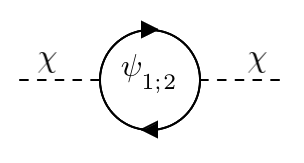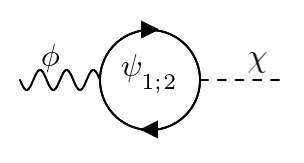Curvilinear magnetism is an emerging field which connects low-dimensional magnetic architectures with their geometrical properties to describe resulting novel phenomena. Nanoscale curved magnetic stripes are a crucial building block in the race for high-density and ultrafast magnetic memory, and can substantially augment the performance of spintronic devices [1,2].
Here, we aim to theoretically and numerically study how changes in the cross-section area of the curved ferromagnetic nanostripe affect its magnetic structure. Namely, we show that tailoring of the gradient of the cross-section area can be used to control the motion of the domain wall. Although, the magnetic response of the curved nanostripe is already well-studied, in all previous studies cross section of the nanowire was assumed to be constant. Only recently, a new micromagnetic framework emerged that allows the exploration of the changes in the magnetization dynamics caused by the cross-section area gradient [3].
Here, we use the collective variable approach by adapting the q-Ф model to stripes with varying cross section. The description of the domain wall motion in ferromagnetic wires is investigated by considering the temporal evolution of the magnetization vector based on the Landau–Lifshitz–Gilbert equation. To derive the specific equations of motion for the collective variables, the Lagrange-Rayleight formalism is used, where the dependency on the spatial variation of the cross-section area is factored in both the Lagrangian and the dissipative function.
The resulting equations of the domain wall motion are studied for three specific geometries: a straight stripe, an arc of a circle and an Euler spiral. For the case of a straight stripe with absent curvature, we show that the domain wall velocity is mainly determined by the cross-section gradient. For the case of constant curvature, the asymptotic domain wall velocity is shown to have two components: the first component is identical to the speed of the domain wall in the straight wire, while the second one describes the coupling between the curvature and the cross-section gradient. For the case of the wire, whose curvature grows at a constant rate, the asymptotic domain wall velocity has two contributions. The first one is the same as the velocity in the straight wire, however, the second one differs from the previous case and is determined solely by the rate of curvature growth. All analytical predictions are wellconfirmed by the NMAG micromagnetic simulations [4].
The gradient of the cross-section area of the curved ferromagnetic nanostripe creates an internal driving force, which in turn induces the domain wall motion and can explain the recent experimental results [5]. We have shown how the dynamics of the domain wall motion can be modified through tailoring the cross-section area of the nanostripe. Although we showcased our approach only for three specific geometries, it is general and can be applied to a wide class of geometries.
- Curvilinear Micromagnetism: From Fundamentals to Applications, edited by D. Makarov and D. Sheka, Topics in Applied Physics Vol. 146 (Springer, Cham, 2022).
- D. D. Sheka, O. V. Pylypovskyi, O. M. Volkov, K. V. Yershov, V. P. Kravchuk, and D. Makarov, Small 18, 2105219 (2022).
- K. V. Yershov, D. D. Sheka, Phys. Rev. B 107, L100415 (2023).
- T. Fischbacher, M. Franchin, G. Bordignon and H. Fangohr, IEEE Transactions on Magnetics, Vol. 43, No. 6, (2007).
- L. Skoric et al. ACS Nano 16, 8860 (2022).


 (a) Loop corrections to the $\phi$ boson mass
(a) Loop corrections to the $\phi$ boson mass
 (b) Diagram of one-loop mixing of light and heavy scalars of
the model
FIG. 1: One-loop diagrams which become significant at low energies for some values of the model coupling.
$~~~~~~~~~~~~~~~~~~~~~~~~~~~~~~~~~~~~~~~~~~~~~~~~~~~~~~~~~~~~~~~~~~~~~~~~~~~~~~~~~~~~~~~~~~~~~~~~~~~~~~~~~~~~~~~~~~~~~~~~~~~~~~~~~~~~~~~~~~~~~~~~~~~~~~~~~~~~~~~~~~~~~~~~~~~~~~~~~~~~~~~~~~~~$
We found out that if $|g_{\phi}|$ and $|g_{\chi}|$ are small, then the loop corrections are negligible and the EL (2) is applicable for description of the scattering processes at low energies. For the values of $m_1$, $m_2$ and $\mu$ chosen in our research this takes place if $|g_{\phi}| < 0.4$ and $|g_{\chi}| < 0.4$.
If $|g_{\chi}|$ is big, then loop corrections to $\chi$ boson mass are considerable even at low energies. In our model, we have that if $|g_{\chi}| > 2.5$ then corrections displayed in Fig.(1a) have a magnitude of more than $10\,\%$ of the $\chi$ boson mass. These corrections suppress the contribution of the heavy scalar in a reaction cross-section. Hence, if $|g_{\chi}|$ is big, then (2) significantly overestimates $\chi$ boson contribution in a cross-section when $\chi$ decouples.
If $|g_{\phi}|$ is not small, then contribution of the scalar fields one-loop mixing is significant in both $s$- and $t$-channels. One-loop mixing of $\phi$ and $\chi$ is introduced by the diagram in Fig.(1b). In our model, we get that if $|g_{\phi}| > 1.5$, then modulus of the contribution of scalars one-loop mixing in the matrix elements of the considered reactions is bigger than $50\,\%$ of the four-fermion interaction term modulus at $s > \mu^2$ and $|t| > \mu^2$. This was observed in the limit when loop correction in Fig.(1a) is negligible.
(b) Diagram of one-loop mixing of light and heavy scalars of
the model
FIG. 1: One-loop diagrams which become significant at low energies for some values of the model coupling.
$~~~~~~~~~~~~~~~~~~~~~~~~~~~~~~~~~~~~~~~~~~~~~~~~~~~~~~~~~~~~~~~~~~~~~~~~~~~~~~~~~~~~~~~~~~~~~~~~~~~~~~~~~~~~~~~~~~~~~~~~~~~~~~~~~~~~~~~~~~~~~~~~~~~~~~~~~~~~~~~~~~~~~~~~~~~~~~~~~~~~~~~~~~~~$
We found out that if $|g_{\phi}|$ and $|g_{\chi}|$ are small, then the loop corrections are negligible and the EL (2) is applicable for description of the scattering processes at low energies. For the values of $m_1$, $m_2$ and $\mu$ chosen in our research this takes place if $|g_{\phi}| < 0.4$ and $|g_{\chi}| < 0.4$.
If $|g_{\chi}|$ is big, then loop corrections to $\chi$ boson mass are considerable even at low energies. In our model, we have that if $|g_{\chi}| > 2.5$ then corrections displayed in Fig.(1a) have a magnitude of more than $10\,\%$ of the $\chi$ boson mass. These corrections suppress the contribution of the heavy scalar in a reaction cross-section. Hence, if $|g_{\chi}|$ is big, then (2) significantly overestimates $\chi$ boson contribution in a cross-section when $\chi$ decouples.
If $|g_{\phi}|$ is not small, then contribution of the scalar fields one-loop mixing is significant in both $s$- and $t$-channels. One-loop mixing of $\phi$ and $\chi$ is introduced by the diagram in Fig.(1b). In our model, we get that if $|g_{\phi}| > 1.5$, then modulus of the contribution of scalars one-loop mixing in the matrix elements of the considered reactions is bigger than $50\,\%$ of the four-fermion interaction term modulus at $s > \mu^2$ and $|t| > \mu^2$. This was observed in the limit when loop correction in Fig.(1a) is negligible.